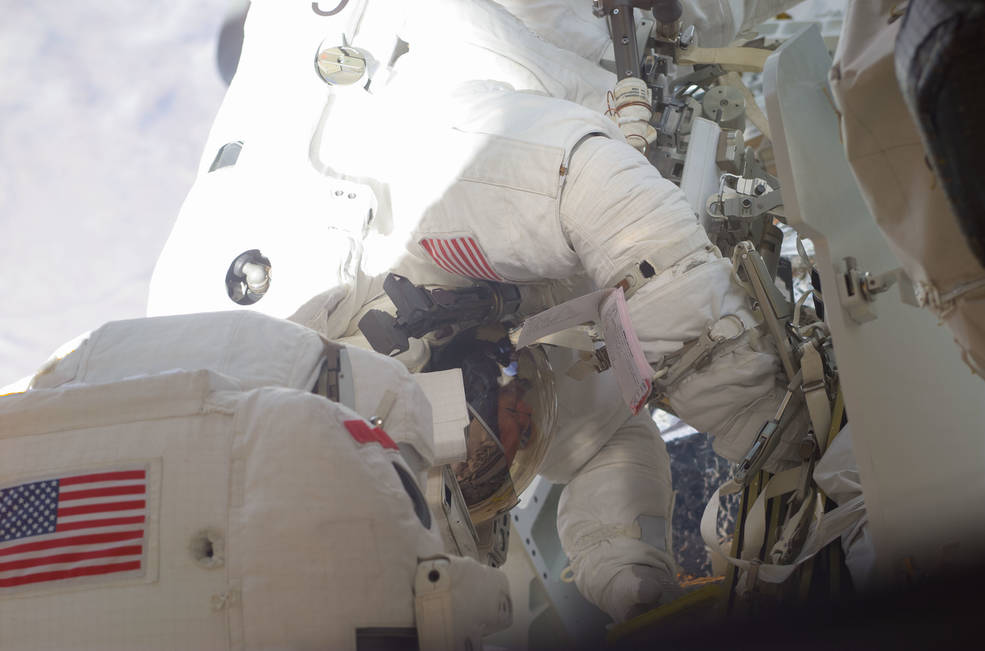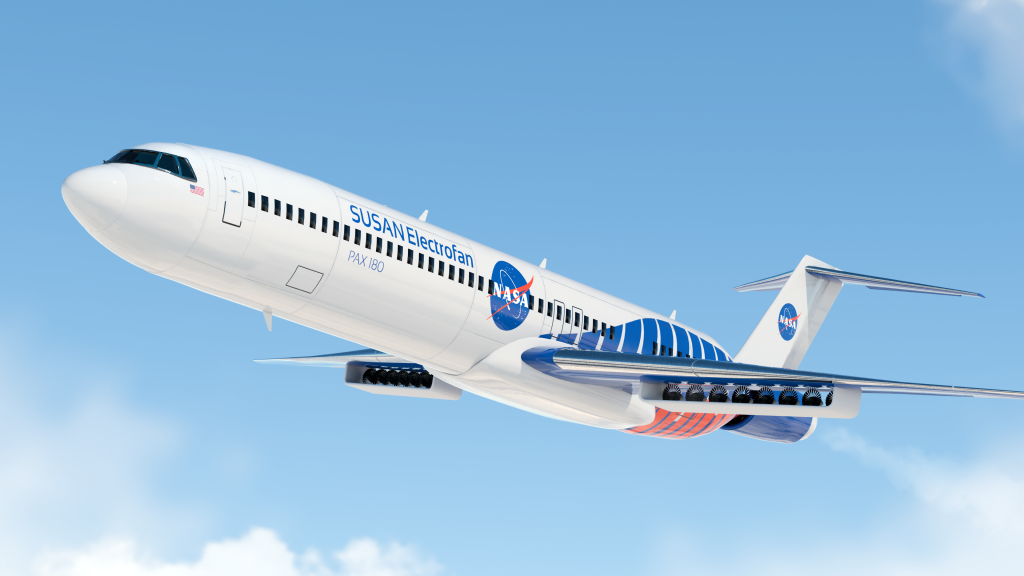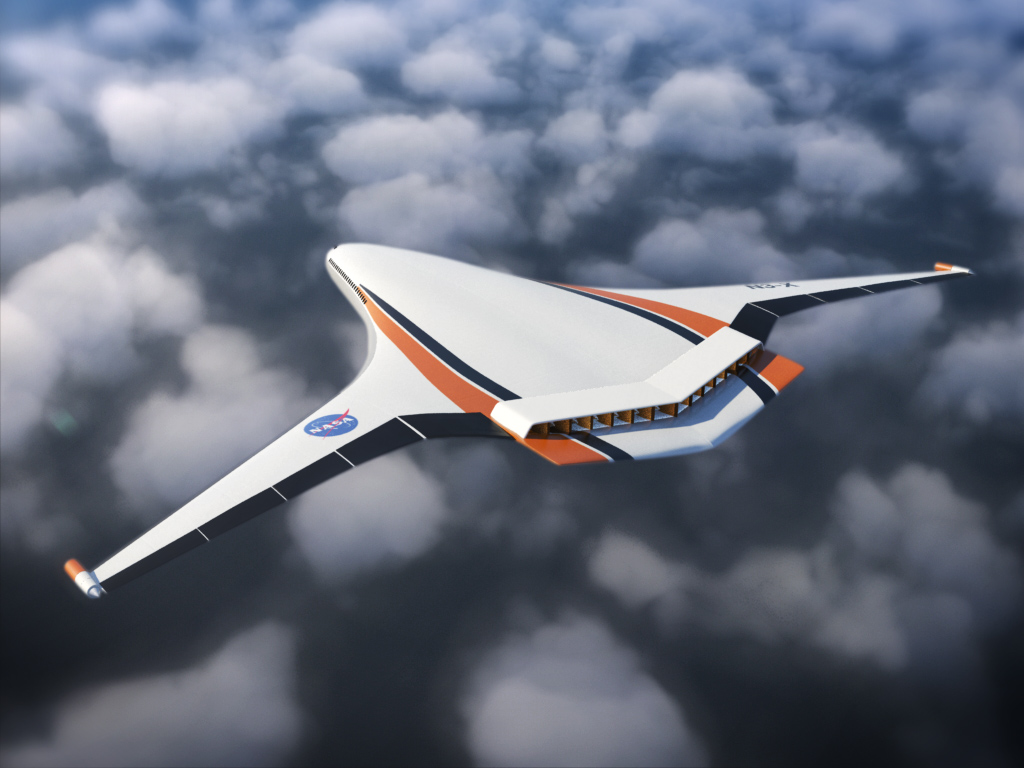In July 2001, the space shuttle Atlantis arrived at the International Space Station during the STS-104 mission, with a five-member crew consisting of NASA astronauts Steven W. Lindsey, Charles O. Hobaugh, Michael L. Gernhardt, Janet L. Kavandi, and James F. Reilly. The primary goal of their mission was the installation, activation, and first use of the Quest Joint Airlock, providing the U.S. segment of the growing facility with an independent spacewalking capability. The Expedition 2 crew of Yuri V. Usachev of Roscosmos and NASA astronauts James S. Voss and Susan J. Helms, aboard the station since March and most recently visited by the STS-100 crew who installed the Canadarm2 robotic arm on the station, had been busy with visiting vehicles, spacewalks, and research activities.



Left: Soyuz TM32 arrives at the space station, the first taxi mission of the program, delivering a fresh
Soyuz spacecraft. Middle: The Expedition 2 and Soyuz TM32 crews in the Zvezda Service Module.
Right: The taxi crew departs the space station aboard the older Soyuz TM31 spacecraft.
On April 30, 2001, the day after the STS-100 crew aboard space shuttle Endeavour departed from the space station, Expedition 2 crew members Usachev, Voss, and Helms welcomed the first Soyuz taxi crew aboard. The primary purpose of the taxi mission was to bring a fresh Soyuz spacecraft to serve as a potential lifeboat for the Expedition 2 crew. The previous Soyuz spacecraft had been attached to the station since Nov. 2, 2000, when it delivered the Expedition 1 crew to the orbital facility, and was nearing the completion of its safe orbital lifetime. Aboard Soyuz TM32 were veteran Russian cosmonauts Talgat A. Musabayev and Yuri M. Baturin and spaceflight participant Dennis A. Tito, the first paying customer to visit the space station. After a week of on-orbit activities, they undocked on May 6 aboard the older Soyuz TM31 and landed in Kazakhstan several hours later.



Left: Expedition 2 astronaut Susan J. Helms activating the Human Research Facility rack in the
Destiny module. Middle: Expedition 2 crew members James S. Voss, left, and Yuri V. Usachev
collecting a blood sample for an inflight biomedical experiment. Right: Voss, left, and Usachev
wearing the liquid cooled ventilation garments for their Russian Orlan spacesuits pose in the
transfer compartment of the Zvezda Service Module prior to the internal spacewalk to install
a docking cone.
Following the departure of the Soyuz taxi crew, the Expedition 2 crew members resumed their onboard research activities. Voss and Helms activated two facilities delivered on previous space shuttle missions, the Human Research Facility Rack 1 and the Expedite the Processing of Experiments for Space Station (EXPRESS) Rack 2, and continued work with experiments in EXPRESS Rack 1, that had been activated earlier in their mission. On May 23, the crew welcomed the arrival of the Progress M1-6 cargo vehicle, bringing food, water, oxygen, and science experiments to the station. On June 8, Usachev and Voss donned Russian Orlan spacesuits to conduct the first Expedition-based spacewalk of the program. The spacewalk was actually an internal activity requiring the depressurization of the transfer compartment of the Zvezda Service Module to install a docking cone onto the Zarya module in preparation for the arrival of the Pirs docking compartment later in 2001. The internal spacewalk lasted just 19 minutes.


Left: The STS-104 crew patch. Right: The STS-104 crew of Michael L. Gernhardt, left,
Charles O. Hobaugh, Janet L. Kavandi, Steven W. Lindsey, and James F. Reilly.
The tenth space shuttle assembly and resupply mission to the space station, STS-104, began in the predawn hours of July 12, 2001, with the launch of space shuttle Atlantis from Launch Pad 39B at NASA’s Kennedy Space Center (KSC) in Florida. Originally scheduled for June 2001, managers delayed STS-104 to allow engineers on the ground to solve computer problems with the space station’s robotic arm, that was required to install the airlock. This also delayed the next mission, STS-105, to August, and since that was Expedition 2’s ride home, the delay extended their stay aboard the station by about one month. Less than two days after launch, Lindsey guided Atlantis to a smooth docking with the station at the Pressurized Mating Adapter-2, or PMA-2, located on the forward end of the Destiny U.S. laboratory module. The two crews briefly opened the hatches between the two spacecraft to transfer some items, and then closed them to allow the shuttle to reduce its internal pressure to prepare for the upcoming spacewalks.



Left: Launch of Atlantis on space shuttle mission STS-104 from NASA’s Kennedy Space Center in Florida.
Middle: View of the International Space Station from Atlantis during the rendezvous and docking maneuver.
Right: View from inside the station of space shuttle Atlantis with the Quest Joint Airlock at the
rear of the payload bay.
The day after the docking, Gernhardt and Reilly exited the shuttle’s airlock to begin the mission’s first spacewalk and prepared Quest for its transfer by removing covers from the module. Helms used the station’s Canadarm2 robotic arm to lift Quest out of the shuttle’s payload bay and install it on the Unity Node 1’s right side berthing port. Gernhardt and Reilly then connected a cable to provide station power to the module. They concluded the first spacewalk after 5 hours and 59 minutes. Over the next few days, the astronauts busied themselves with activating the newest addition to the space station, performing leak checks and stowing equipment in the airlock. During their second spacewalk on July 18, Gernhardt and Reilly installed one nitrogen and two oxygen high pressure tanks to the exterior of the new airlock, assisted by Helms operating the station’s arm to transfer the tanks from the shuttle’s payload bay and Kavandi using the shuttle’s arm to move the astronauts around. The second excursion lasted 6 hours and 26 minutes.


Left: The space station’s robotic arm transferring the Quest Joint Airlock.
Right: STS-104 astronauts Michael L. Gernhardt, left, and James F. Reilly work
in the shuttle’s payload bay during the mission’s first spacewalk.
On July 20, the 32nd anniversary of the Apollo 11 Moon landing and the first spacewalk on the Moon, Gernhardt and Reilly depressurized the crew lock and began the first spacewalk from the Quest Joint Airlock. The main task during the 4-hour 1-minute excursion was to attach the final nitrogen tank to the exterior of the new module. To date, shuttle and station crewmembers have completed 93 spacewalks from the Quest airlock, a module critical to the assembly and maintenance of the orbiting laboratory.


Left: The Expedition 2 and STS-104 crews pose inside the newly delivered and outfitted Quest
Joint Airlock. Right: STS-104 astronauts James F. Reilly, left, and Michael L. Gernhardt in the
crew lock portion of the Quest Airlock about to begin the first spacewalk from the new module.


Left: Expedition 2 cosmonaut Yuri V. Usachev prepares a celebratory meal for the joint crews
in the Zvezda Service Module. Right: The STS-104 crew pose in the shuttle’s middeck following
their successful mission to the space station.
On July 22, with Hobaugh at the controls, the shuttle undocked from the space station. He flew Atlantis around the station as the crew photographed it, with the newly installed Quest Joint Airlock clearly visible. Two days later, Lindsey brought Atlantis home for a smooth night landing at the shuttle landing facility at KSC. The mission to provide the space station with an independent spacewalking capability lasted 12 days 18 hours 36 minutes.


Left: The International Space Station photographed by the STS-104 crew during
departure, with the station’s robotic arm pointing to the newly installed Quest
Joint Airlock. Right: Space shuttle Atlantis making a night landing at NASA’s
Kennedy Space Center in Florida.
Enjoy the crew-narrated video about the STS-104 mission.
To be continued…




























